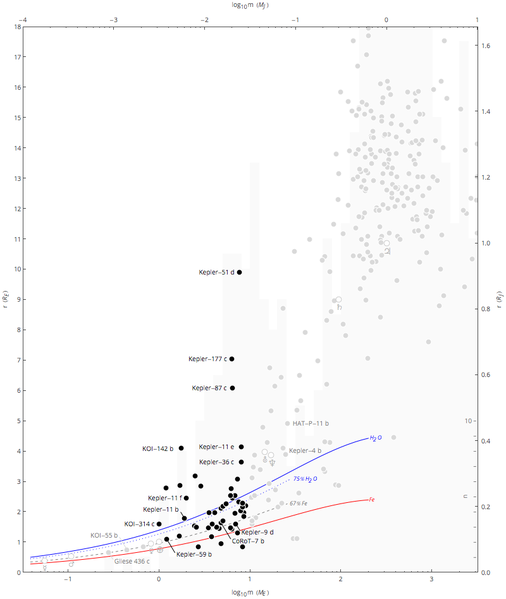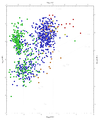चित्र:Exoplanet Mass-Radius Scatter Super-Earth.png

मूल फ़ाइल ((८०० × ९४७ पिक्सेल, फ़ाइल का आकार: ६९ KB, MIME प्रकार: image/png))
सारांश
| विवरणExoplanet Mass-Radius Scatter Super-Earth.png |
English: Scatter plot of super-Earth characteristics in context showing the mass, m, and radius, r, for
compared with those of along with detected through 2014-04-19. Scales indicate (log10 of) planetary mass, m, expressed as Earth masses (bottom) and Jupiter masses (top); planetary radius, r, expressed in Earth radii (left) and Jupiter radii (right); and counts n (gray ticks on right). References lines are provided for approximate mass-radius relationships[1] for selected planetary compositions: Exoplanet data is from the Open Exoplanet Catalogue,[2] version 4945b99. The figure shows all planets up to 10 MJ (omitting 59 more massive planets), and transiting planets up to 18 RE (omitting an additional 17 with m ≤ 10 MJ but r > 18 RE). PSR B1257+12 b (with m < 10-4 MJ), lies off to the left of the graph, and is also omitted. Important note: This figure is intended to serve as a catalog of generally accepted candidate exoplanets using the distribution of some of their basic properties related to detection. No attempt has been made to characterize the degree of confidence (which varies widely) in the existence of a given planet or its properties. Nor is any attempt made to convey systematic errors associated with a particular method. In particular, the indicated mass, m, for an exoplanet characterized using radial velocity is the minimum mass (so that the actual distribution of masses for non-transiting planets may be shifted and "smeared" significantly to the right).
|
| दिनांक | |
| स्रोत | अपना कार्य |
| लेखक | Aldaron, a.k.a. Aldaron |
| दूसरे संस्करण |
Related graphs
|
लाइसेंस
| Public domainPublic domainfalsefalse |
| मैं, इस कार्य का/की कॉपीराइट धारक, इस कार्य को सार्वजनिक डोमेन में प्रकाशित करता/करती हूँ। यह पूरे विश्व में लागू होता है। कुछ देशों में यह कानूनी तौर पर नहीं हो सकता है; ऐसा हो तो: मैं सभी को इस कार्य का इस्तेमाल किसी भी उद्देश्य से, बिना किसी बाधाओं के इन शर्तों के कानून द्वारा अनिवार्य किए तक करने की अनुमति देता/देती हूँ। |
Captions
Items portrayed in this file
चित्रण
२५ अप्रैल 2014
source of file अंग्रेज़ी
original creation by uploader अंग्रेज़ी
फ़ाइल का इतिहास
फ़ाइलका पुराना अवतरण देखने के लिये दिनांक/समय पर क्लिक करें।
| दिनांक/समय | अंगूठाकार प्रारूप | आकार | प्रयोक्ता | प्रतिक्रिया | |
|---|---|---|---|---|---|
| वर्तमान | १२:४६, २५ अप्रैल २०१४ |  | ८०० × ९४७ (६९ KB) | wikimediacommons>Aldaron | Tidy labels. |
फ़ाइल का उपयोग
निम्नलिखित पन्ने इस चित्र से जुडते हैं :
मेटाडाटा
इस फ़ाइल में बढ़ाई हुई जानकारी हैं, हो सकता है कि यह फ़ाइल बनाने में इस्तेमाल किये गए स्कैनर अथवा कैमेरा से यह प्राप्त हुई हैं। अगर यह फ़ाइल बदलदी गई है तो यह जानकारी नई फ़ाइल से मेल नहीं खाने की आशंका है।
| होरिज़ॉंटल रिज़ोल्यूशन | २८.३५ dpc |
|---|---|
| वर्टिकल रिज़ोल्यूशन | २८.३५ dpc |
| इस्तेमाल किया हुआ सॉफ्टवेयर |
|
| डिजिटाइज़िंग का दिनांक और समय |
|

